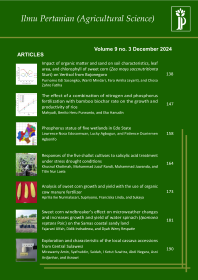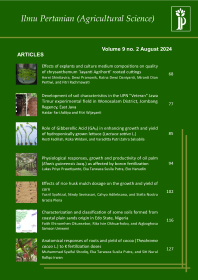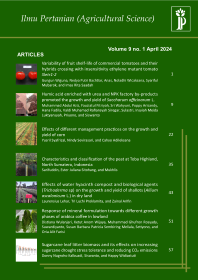Population of Herbivorous and Carnivorous Arthropods in Rice Field Ecosystem Modified with Vermicompost and Flower Plants
Suparni Suparni(1*), Nugroho Susetya Putra(2), Suputa Suputa(3)
(1) Departement of Plant Pest and Disease, Faculty of Agriculture, Universitas Gadjah Mada
(2) Departement of Plant Pest and Disease, Faculty of Agriculture, Universitas Gadjah Mada
(3) Departement of Plant Pest and Disease, Faculty of Agriculture, Universitas Gadjah Mada
(*) Corresponding Author
Abstract
Keywords
Full Text:
PDFReferences
Allifiah, A. N. A. F., W. Yanuwiadi, Z. P. Gama, dan A. S. Leksono. 2013. Refugia Sebagai Mikrohabitat untuk Meningkatkan Peran Musuh Alami di Lahan Pertanian. Prosiding FMIPA Universitas Pattimura: 113-116.
Aryantha, I. P. 2002. Membangun Sistem Pertanian Berkelanjutan. paper presented to Development of Sustainable Agricultural System, One Day Discussion on The Minimization of Fertilizer Usage. Jakarta, 6 May.
Banerji, D. K., P. K. Nanda, P. K. Bera, and S. C. Sen. 1993. Seasonal Abundance of Important Some Spider Groups in Rice Agroecosystem. Records of the Zoological Survey of India, 93: 275-281.
Bilde, T., J. A. Axelsen, and S. Toft. 2000. The Value of Collembola from Agricultural Soils as Food for a Generalist Predator. Journal of Applied Ecology, 37: 672-683.
Chandra, K. 2005. Organic Manure. Banglaore, India: Regional Centre of Organic Farming, pp. 1-46.
Entling, M. H. S. and J. Dobeli. 2009. Sown Wild Flower Areas to Enhance Spiders in Arable Fields. Agriculture Ecosystems and Environment Journal, 133: 19–22.
Frank, T. and I. Kunzle. 2006. Effect of Early Succession in Wildflower Areas on Heteroptera Assemblages (Insecta: Heteroptera). European Journal of Entomology, 103(1): 61-70.
Hadi, M., R. C. H. Soesilohadi, F. X. Wagiman, dan Y. R. Suhardjono. 2015. Keragaman Arthropoda Tanah pada Ekosistem Sawah Organik dan Sawah Anorganik (Diversity of Soil Arthropods in Organic and Inorganic Paddy Rice Field Ecosystem). Prosiding Seminar Nasional Masyarakat Biodiv Indon. 1(7): 1577-1581.
Hanafiah, K. A. 2010. Rancangan Percobaan: Teori dan Aplikasi. Ed. Ketiga. Jakarta: Rajawali pers, pp. 260.
Herlinda, S., Waluyo, S. P. Estuningsih, dan C. Irsan. 2008. Perbandingan Keanekaragaman Spesies dan Kelimpahan Arthropoda Predator Penghuni Tanah di Sawah Lebak yang Diaplikasi dan Tanpa Aplikasi Insektisida. J. Entomol. Indon., 5(2): 96-107.
Kariada, I. K., dan I. B. Aribawa. 2005. Pengaruh Residu Jenis dan Dosis Pupuk Organik terhadap Pertumbuhan dan Hasil Padi di Subak Rejasa Kabupaten Tabanan Bali. [online] BPTP Bali. Available at: http://ntb.litbang. pertanian.go. id/document.php?folder=ind/2006/TPH&filename=pengaruhsistem&ext=doc [Accessed 27 November 2015].
Krakos K., A. M. Booth, J. S. Ardner and M. Eipp. 2011. Nectar for Plant Defense: the Feeding of the On-Active Coccinellid Beetle, Curinus coeruleus, on Extra-Floral Nectaries of Hawaiian Native Hibiscus Brackenridgei. International Journal of Insect Science, 3: 11–21.
Krebs, C. J. and A. J. Kenney. 2011. Program for Ecological Methodology. 2nd ed. Vancouver, Canada: Dept of Zoology University of British Columbia.
Laba, I. W., K. Djatnika, dan M. Arifin. 2000. Analisis Keanekaragaman Hayati Musuh Alami pada Ekosistem Padi Sawah. Prosiding Simposium Keanekaragaman Hayati Arthropoda pada Sistem Produksi Pertanian, PEI–KEHATI: 207-217.
Marpaung, A. E. 2014. Pemanfaatan Pupuk Organik Padat dan Pupuk Organik Cair dengan Pengurangan Pupuk Anorganik terhadap Pertumbuhan Tanaman Jagung (Zea mays L). Jurnal Saintech, 6 (4).
Muhibah, T. I. dan A. S. Leksono. 2015. Ketertarikan Arthropoda terhadap Blok Refugia (Ageratum conyzoides, Capsicum frutescens, dan Tagetes erecta) dengan Aplikasi Pupuk Organik Cair dan Biopestisida di Perkebunan Apel Desa Poncokusumo. Jurnal Biotropika, 3(3): 123-127.
Pimentel, D. and C. A. Edwards. 1982. Pesticides and Ecosystems. Bio Science, 32(7): 595-600.
Pimentel, D., H. Acquay, M. Biltonen, P. Rice, M. Silva, J. Nelson, V. Lipner, S. Giordano, A. Horowitz, and M. W. D'Amore. 1992. Environmental and Economic Costs of Pesticide Use. Bio Science, 42(10): 750-760.
Salmon, S. and J. F. Ponge. 2001. Earthworm Excreta Attract Soil Springtails: Laboratory Experiments on Heteromurus nitidus (Collembola: Entomobryidae). Soil Biology and Biochemistry, 33: 1959-1969.
Saona, C. R., B.R. Blaauw, and R. Isaacs. 2011. Manipulation of Natural Enemies in Agroecosystems: Habitat and Semiochemicals for Sustainable Insect Pest Control. In: M. L. Larramendy and S. Soloneski, ed., Integrated Pest Management and Pest Control- Current and Future Tactics, 1st ed. Croatia: InTech, pp. 89-126.
Sato, M. 1991. Comparative Morphology of The Mouthparts of The Family Dolicophodidae (Diptera). New Series, 45: 49-75.
Settle, W. H., H. Ariawan, E. T. Astuti, W. Cahyana, A. H. Hakim, D. Hindayana, and A. S. Lestari. 1996. Managing Tropical Rice Pests Through Conservation of Generalist Natural Enemies and Alternative Prey. Ecology, 77 (7): 1975-1988.
Sigsgaard, L., S. Toft and S. Villareal. 2001a. Diet Dependent Fecundity of The Spiders Atypena formosana and Pardosa pseudoannulata, Predators in Irrigated Rice. Agricultural and Forest Entomology, 3: 285-295.
Sigsgaard, L., S. Toft and S. Villareal. 2001b. Diet Dependent Survival, Development and Fecundity of The Spider Atypena formosana (Oi) (Araneae: Linyphiidae) - Implication for Biological Control in Rice. Biological Science and Technology, 11: 233-244.
Silveira, L.C.P., E. B. Filho, L. S. R. Pierre, F. S. C. Peres, J. N. C. Louzada. 2009. Marigold (Tageteserecta L.) as an Attractive Crop to Natural Enemies in Onion Fields. Sci. Agric. (Piracicaba, Braz.), 66 (6): 780-787.
Supartha, N. Y., G. Wijana, dan G. M. Adnyana. 2012. Aplikasi Jenis Pupuk Organik pada Tanaman Padi Sistem Pertanian Organik. E- Jurnal Agroekoteknologi Tropika, 1( 2): 96-97.
Tonguc, A., I. Y. Grichanov, and S. Naglis. 2016. Checklist of the Dolicophodidae (Diptera, Brachycera) of Turkey. Turkish Journal of Zoology, 40: 14-26.
Widiarta, I. N., D. Kusdiaman, dan Suprihanto. 2006. Keragaman Arthropoda Pada Padi Sawah Dengan Pengelolaan Tanaman Terpadu. J. HPT Tropika, 6(2): 61–69.
Wilkin, K. M., D. D. Ackerly, and S. Stephens. 2016. Climate Change Refugia, Fire Ecology and Management. Forests, 7(4): 77-90.
Article Metrics
Refbacks
- There are currently no refbacks.
Ilmu Pertanian (Agricultural Science) ISSN 0126-4214 (print), ISSN 2527-7162 (online) is published by Faculty of Agriculture Universitas Gadjah Mada collaboration with Perhimpunan Sarjana Pertanian Indonesia (PISPI) and licensed under a Creative Commons Attribution-ShareAlike 4.0 International License.













